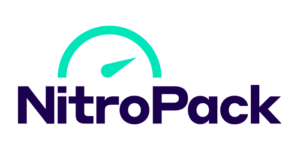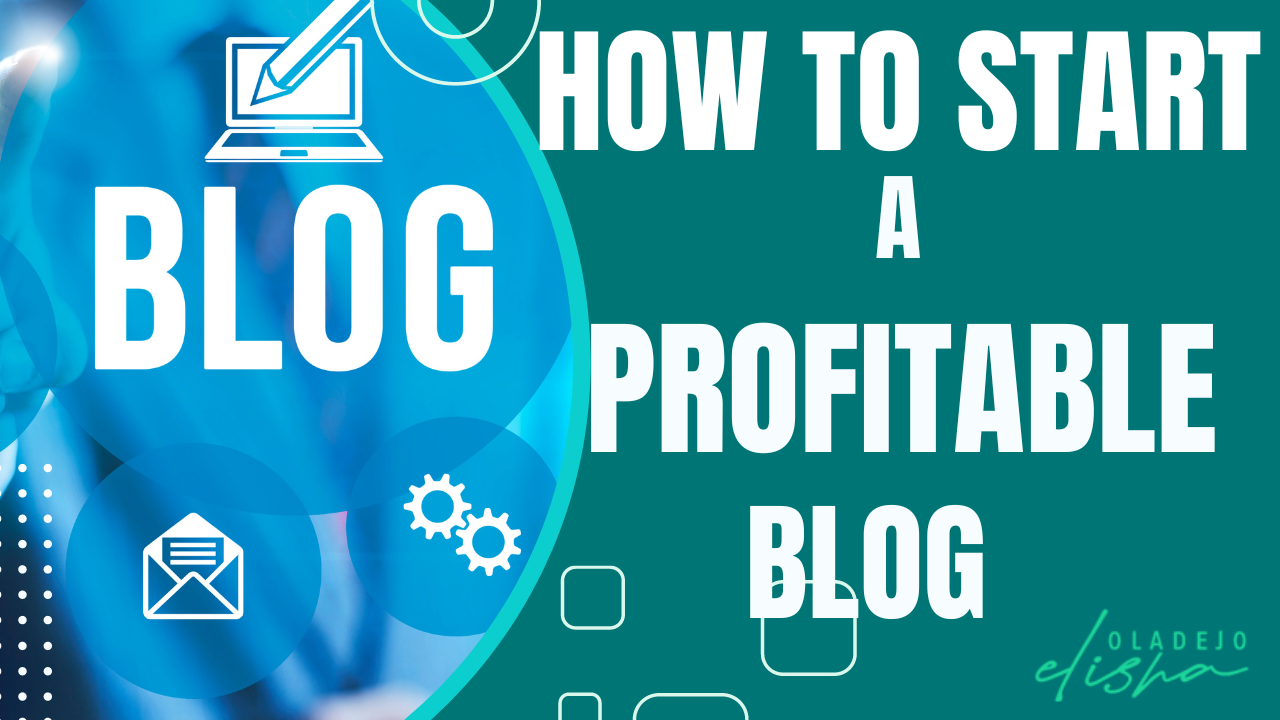Well, isn’t the digital age just grand? Here I am, sipping my morning coffee while writing about the exciting world of affiliate marketing blogs.
But this isn’t just about me or my caffeine habit. You’re here because you, too, see the potential this online world holds.
Now, I could regale you with tales of bloggers earning six-figure sums from their living rooms, but let’s skip the fairy tales and get down to business.
See, the magic ingredient isn’t a secret blogging platform or some mystical search engine optimization chant performed at midnight. Nope, it’s simpler than that: it’s starting your affiliate blog the right way.
That’s exactly what we’re going to walk through together in this post. Consider this your personal roadmap, your step-by-step guide on how to start a successful affiliate blog.
We’ll be diving into everything from picking your niche, choosing the right blogging platform, and even unraveling the enigma that is search engine optimization.
So, if you’ve ever thought about starting an affiliate blog, you’re in the right place. By the time we’re done here, you’ll be well on your way to building a successful affiliate marketing blog.
If you are just looking for the best web hosts to run a successful affiliate blog? Here are my top picks:
Rocket.net: Known for its blazing-fast hosting speed and impeccable customer service, Rocket.net is a top choice for many successful affiliate marketers. Its built-in performance optimizations mean your blog is set up for success from day one, ensuring a smooth user experience that can lead to increased affiliate clicks and conversions.
Hostinger: As a cost-effective option, Hostinger attracts many new affiliate marketers on a budget. Its user-friendly control panel and solid performance offer a great starting point for beginners in the affiliate marketing realm.
Siteground: With top-tier reliability and excellent customer support, Siteground is another preferred choice among affiliate marketers. Its range of features, including automatic updates and daily backups, make managing an affiliate blog worry-free, allowing you to focus on creating content and boosting your affiliate income.
Think you have 15mins more to spare? Join me as I tackle everything involved in running a successful affiliate marketing blog.
Understanding Affiliate Marketing

Before we start laying the bricks for your affiliate marketing empire, it’s important that we understand what we’re building.
Just like you wouldn’t whip up a soufflé without knowing the difference between a whisk and a spatula, you can’t expect to succeed in affiliate marketing without understanding its core principles.
Think of affiliate marketing like this: it’s a way to earn money by recommending products or services to your audience.
Imagine you write a blog post about the latest, most effective yoga mat, and you provide an affiliate link to where your readers can buy it. Every time someone clicks on that link and makes a purchase, you earn a commission. Voilà, you’ve just become an affiliate marketer!
Now, it may sound as easy as pie, but trust me, it’s not about throwing a couple of affiliate links in your post and hoping for the best. You’ve got to find affiliate programs that align with your blog’s theme and audience. And, you’ll need to convince search engines (and your readers) that your content is top-notch and worth their time.
But hey, no pressure, we’re in this together, remember? Let’s take a deeper look at how it all works.
How Affiliate Marketing Works
You might wonder, ” How do I make money from affiliate marketing?” Well, it begins with you joining an affiliate program.
These programs provide you with unique affiliate links for promoting their products or services on your blog. Each time someone clicks your link and makes a purchase, you earn a commission. This is how you generate affiliate revenue.
It’s like being a salesperson but without the cold calls or the need to wear a fancy suit. You’re simply promoting affiliate products that resonate with your audience and are relevant to your profitable niche. The beauty of it all? The harder you work, the more potential you have to earn!
Benefits of Affiliate Marketing
Now, let’s talk about the good stuff – the benefits of being an affiliate marketer.
The first one that comes to mind is the potential for passive income. Yes, you heard me right! Once your blog gains traction, it can earn you money while you sleep, go on vacation, or binge-watch your favorite Netflix series.
Another significant benefit is the low entry barrier. You don’t need a hefty amount of startup capital to get your blog up and running. All you need is a bit of time, a sprinkle of patience, and a dash of dedication.
Finally, affiliate marketing gives you the freedom to work from anywhere. All you need is your trusty laptop and a reliable internet connection. Say goodbye to the dreaded commute and hello to the flexibility of working in your PJs!
So, are you ready to dive into the exciting world of affiliate marketing? The journey may have its ups and downs, but I assure you, the rewards are worth it.
Choosing the Right Niche

Deciding on the right niche is like finding the perfect pair of jeans – it needs to fit just right and make you feel like a million bucks. That’s because your niche is essentially the foundation of your affiliate website. It determines the type of content you create, the products you promote, and, most importantly, the audience you cater to.
When you’re eager to start affiliate marketing, it can be tempting to leap headfirst into a broad topic you think everyone will love. But trust me, going too broad is like trying to shout in a crowded room – hardly anyone hears you.
On the other hand, if you choose a specific niche, it’s like having a heart-to-heart conversation with a friend. You establish a real connection, and your message is heard clearly. By focusing on a specific niche, you’re more likely to drive affiliate sales as you’re addressing the needs and wants of a targeted audience.
Factors to Consider When Choosing a Niche
So how do you choose the right niche? It’s a mix of personal interest, audience demand, and profitability. First, choose a topic you’re passionate about. This will make creating content less of a chore and more of a joy.
Next, use tools like Google Analytics and keyword research tools to understand the demand for your chosen niche.
Finally, investigate the profitability of your niche. Look for products in your niche on various affiliate network platforms and consider the commission rates they offer.
Examples of Profitable Niches
Now, for some real-world examples. Health and wellness, personal finance, travel, and technology are all profitable niches that you might want to consider. Within these broad categories, you can find more specific niches.
For instance, within health and wellness, you could focus on vegan diets or home workout equipment.
In the realm of personal finance, topics could range from frugal living tips to investing in cryptocurrencies.
The key is to dive deep into niche research and find a sweet spot where your passion meets audience demand and profitability.
Remember, finding the right niche may require some time and research. Still, it’s a crucial step you can’t afford to skip in your affiliate marketing journey.
Setting Up Your Affiliate Blog

Setting up your affiliate blog is like preparing a delicious meal – you need the right ingredients and tools to bring your creation to life.
One of these key tools is your blogging platform, and I’ve got just the one for you. Let’s discuss each step of starting your affiliate blog in detail.
Step 1: Choose the Right Blogging Platform (WordPress)

Choosing the right blogging platform is akin to picking the right car. You want something reliable, customizable, and powerful enough to take you where you want to go. That’s where WordPress comes in.
For many affiliate marketers, WordPress is the trusty steed that carries them to success. Why, you ask? It’s user-friendly, highly customizable, and offers a treasure trove of plugins to optimize your affiliate website. I mean, if it’s good enough for 43% of the web, it’s good enough for us, right?
Navigating the WordPress dashboard might seem daunting at first, almost like stepping into the cockpit of an airplane. But trust me, once you’ve figured out where everything is, you’ll be flying in no time.
WordPress simplifies the technical side of things, allowing you to focus on what really matters – creating content that connects with your audience and drives your affiliate marketing efforts.
Remember, setting up your blog is the first step towards becoming an affiliate marketer. So buckle up, and let’s get this WordPress site of yours up and running!
Step 2: Purchasing Domain and Hosting

As we continue building the infrastructure for your affiliate marketing success, let’s talk about another crucial piece of the puzzle – your domain and web hosting. It’s like the plot of land and the concrete foundation of your online home. So, let’s roll up our sleeves and dig in!
Purchasing a domain is like buying a little slice of the internet that’s exclusively yours. It’s your web address, your virtual storefront, and it’s how your audience will find you amidst the bustling online marketplace.
You can get domains from several providers, including Namecheap.
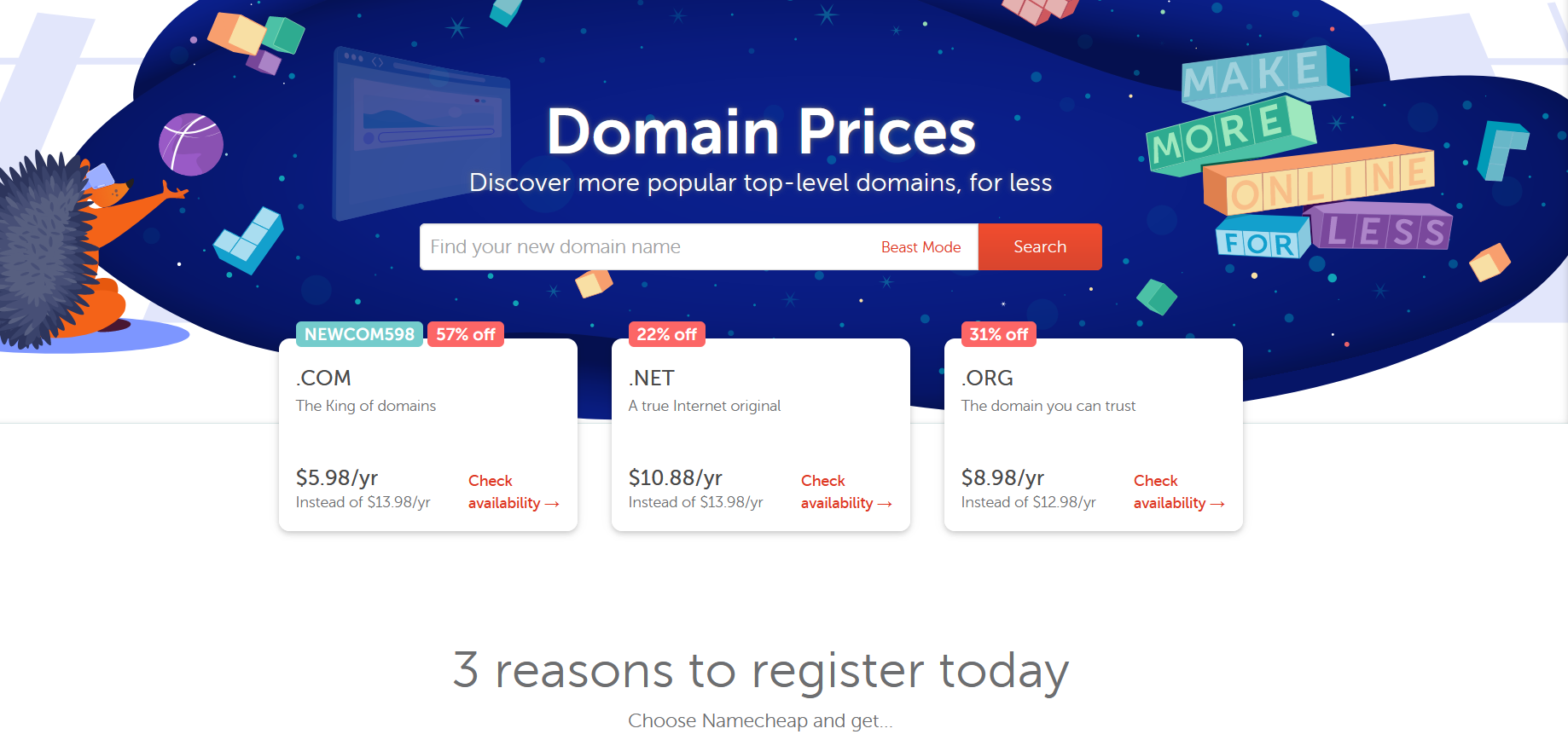
But a domain name alone won’t cut it. You need web hosting, the ‘land’ where your website lives.
It’s the engine that powers your website, ensuring it’s accessible to internet users around the globe. Choosing a reliable web host is crucial as it affects your site’s performance, which in turn impacts your search rankings and, ultimately, your affiliate income.
When it comes to web hosting providers, there are a handful that I can personally vouch for. Hostinger and Siteground are both solid choices, offering good performance and customer service.
But if you’re serious about making money through the best affiliate marketing practices and attracting more traffic to your site, I cannot recommend Rocket.net enough.
About Rocket.net
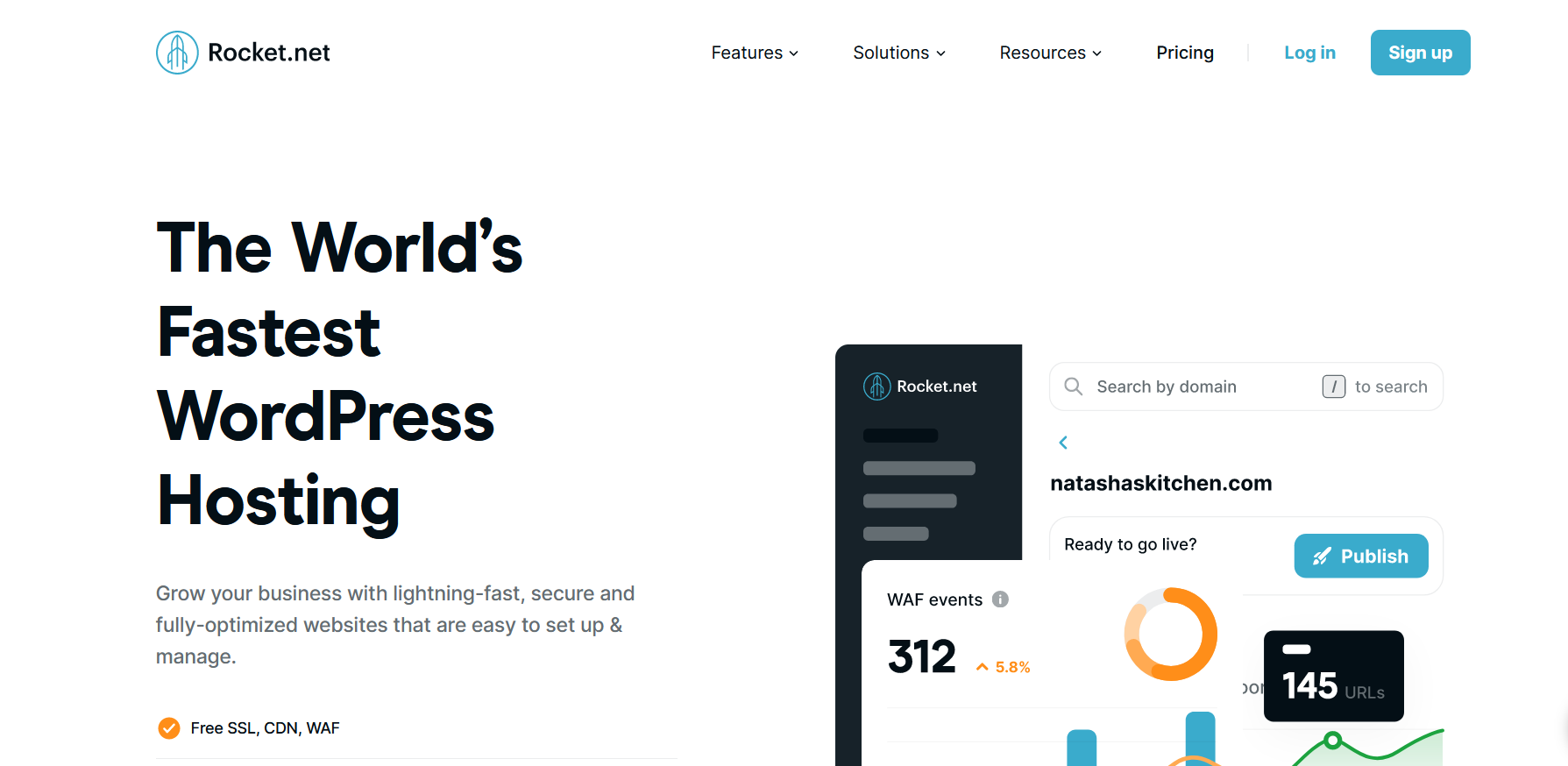
Rocket.net is like the Rolls Royce of hosting. It provides unparalleled speed, robust security, and top-notch customer support, all of which are essential for running a successful affiliate blog.
The faster your site, the better the user experience, and the more likely visitors are to stick around, clicking your affiliate links and contributing to your affiliate income.
Setting Up Your Affiliate Blog with Rocket.net: A Simple Guide
- Start off by selecting the right plan for your needs. If you’re new to Rocket.net, take advantage of their first-month offer and get started for just $1.

Already have an affiliate blog but want to make the switch? Rocket.net offers free migration through its dashboard (known as Mission Control). In my experience, the whole process was done and dusted in less than 2 hours.
- Once you’ve picked and paid for your plan, head on over to the main dashboard. Here, you’ll find a “Create Site” button just begging to be clicked. Go ahead, and click it. You’ll then be asked to christen your WordPress site with a name and domain.
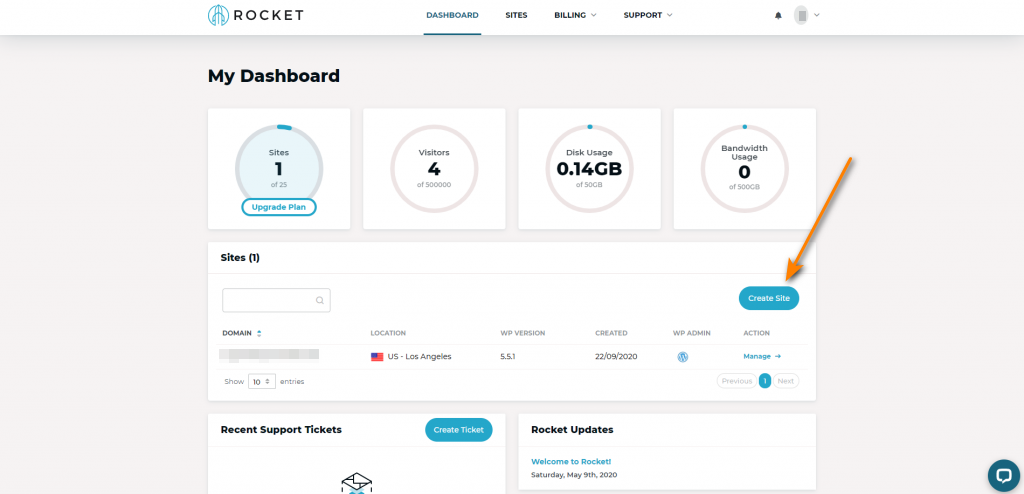
- The next step in your blog setup journey is choosing a server location. To provide the best experience for your audience, select a location that’s closest to your primary customer base.
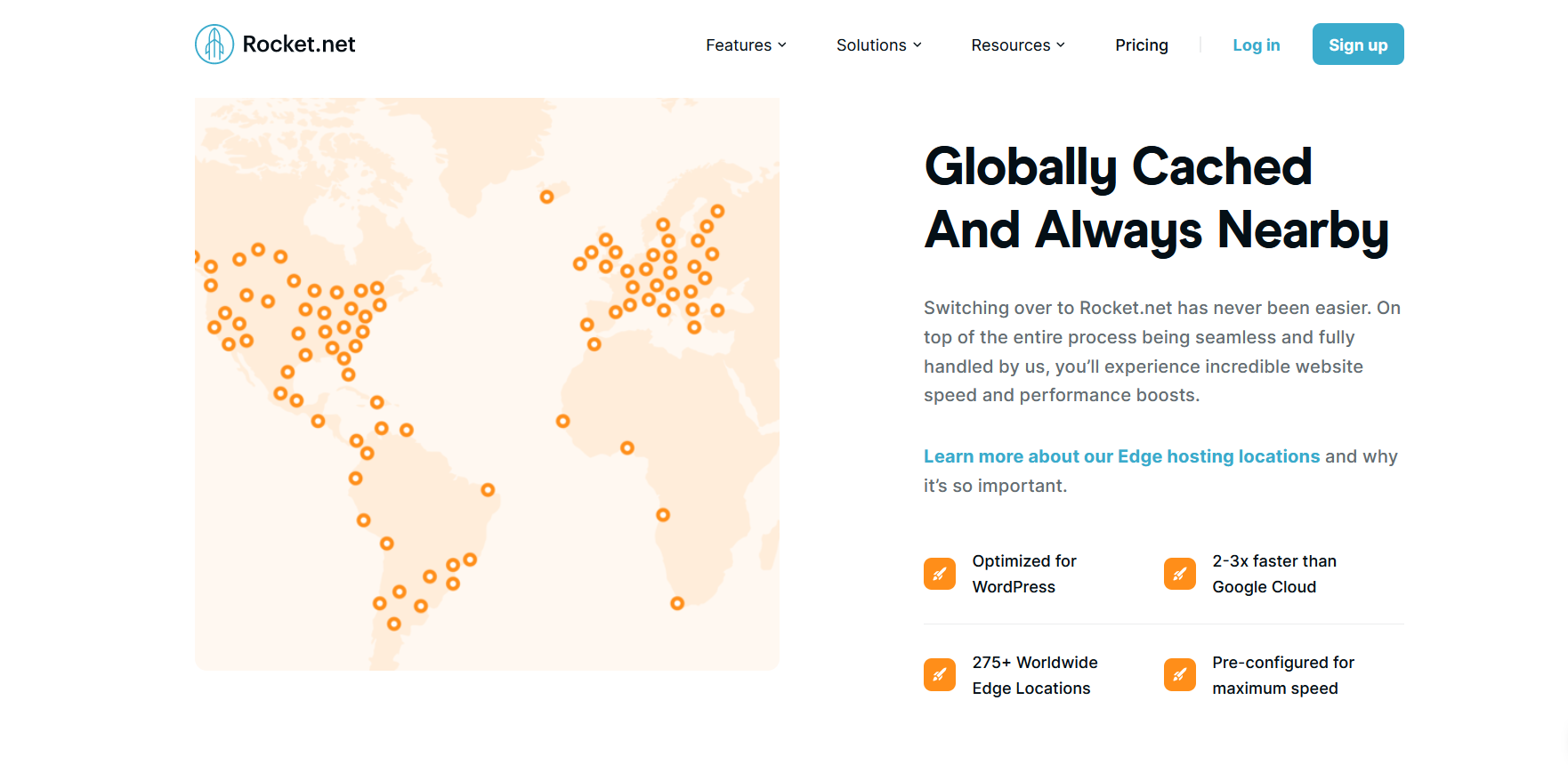
- Now, it’s time to establish your administrative credentials for your WordPress site. You’ll need to provide an administrator username, password, and email address. This is like receiving the keys to your new online home.Up next, pick your preferred language and, if necessary, select multisite support and/or WooCommerce. This tailors the experience to your specific needs.
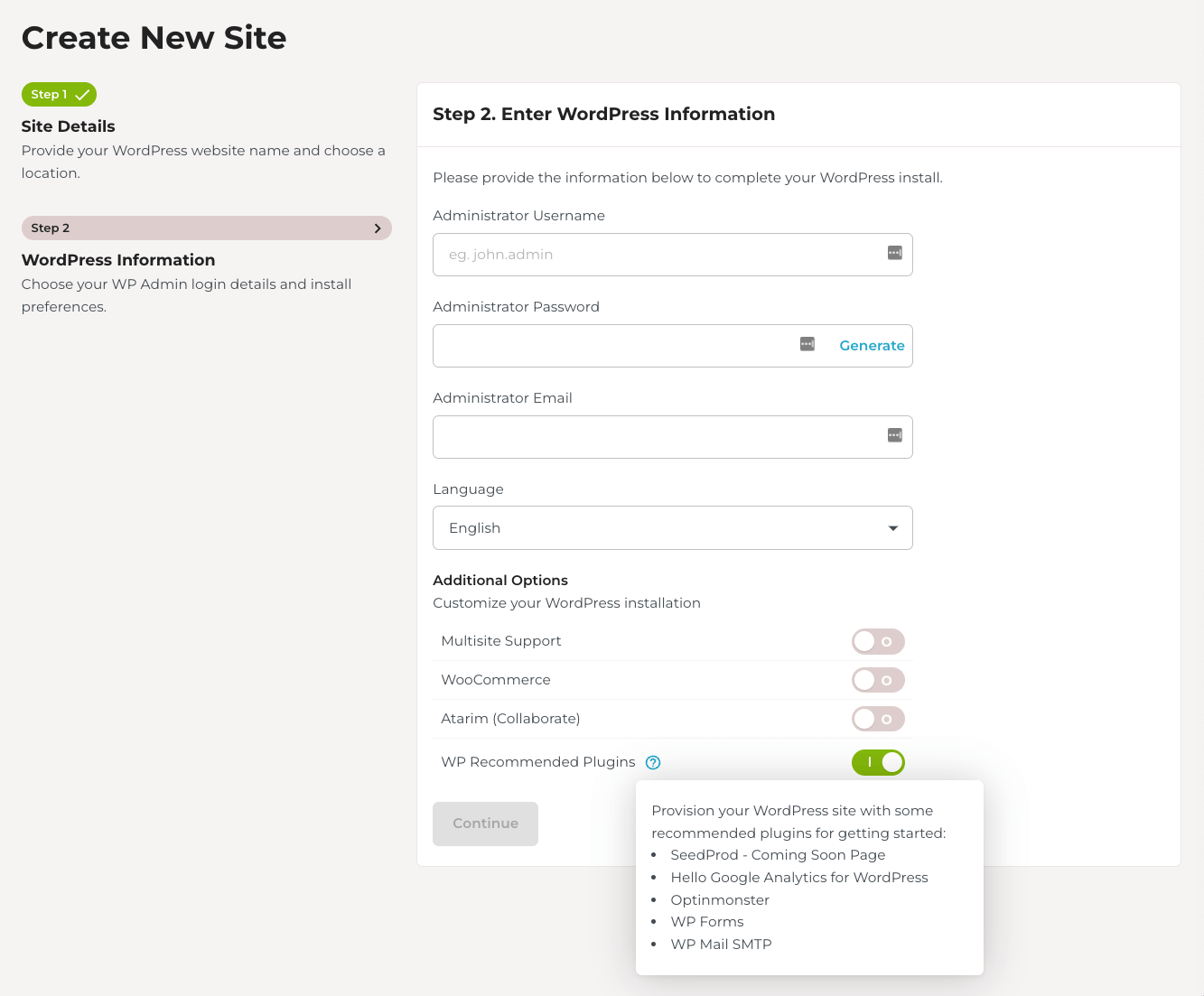
- Almost there! You’ll now navigate to the dashboard for your new blog. Look out for the “Get Started” button and follow the step-by-step guide on the left-hand side of the page. Before you know it, you’ll be crafting high-quality content and start blogging on your own platform.

Remember, a well-hosted website is key to making your online presence felt and your affiliate marketing venture a success. So take your time and choose a hosting provider that suits your needs and budget.
Step 3: Install Necessary Plugins

With your blog set up and ready to go, it’s time to give it some extra oomph.
Think of it as decking out your car with all the cool and necessary features to make it roadworthy and, well, awesome. In the world of affiliate blogging, these ‘cool features’ come in the form of plugins.
Plugins are like the secret sauce of a successful affiliate blog. They’re tools that enhance your website’s functionality and make your life as a blogger so much easier. Let me tell you about a few that I consider non-negotiable.
First up is a plugin for Google Analytics. It’s like a compass guiding you through the wilderness of the online world. With it, you can track your blog’s performance, understand your audience better, and make data-driven decisions that boost your affiliate marketing efforts.
Next, let’s talk about SEO and keyword research plugins. These tools are like your personal fitness trainers, pushing you to optimize your content and climb the ranks of search engine results. They help you find the right keywords to target and give you actionable tips to improve your SEO.
And, of course, there are plugins designed specifically for affiliate networks. These are your personal assistants, helping you manage and track your affiliate links. They can automate many tedious tasks, freeing up your time to focus on creating stellar content and growing your affiliate income.
Remember, these plugins are your allies in the journey of affiliate blogging. Choose them wisely, and they’ll pave your way to success.
Step 4: Design and Customize Your Blog

With your blog set up and the necessary plugins installed, you’re now ready for one of the most creative and exciting parts of the process – designing and customizing your blog.
Imagine being an interior designer but for your online space. You get to choose your blog’s colors, layout, and overall vibe.
Designing your blog is like giving it a personality. It’s what sets it apart from the millions of other sites on the Google search results page. It’s what makes your readers feel at home, compelling them to stay, explore, and ultimately, engage with your blog’s content.
To start, you’ll want to select a theme for your blog. Think of it as the base layer of your design. Now, there are thousands of WordPress themes out there, but there’s one that stands head and shoulders above the rest when it comes to affiliate marketing work – the Astra Theme.

Astra is a WordPress theme designed with performance in mind. It’s lightweight, customizable, and SEO-friendly. What’s more, it comes with pre-built templates, so even if you’re not a design whiz, you can still create a stunning blog.
Once you’ve chosen your theme, it’s time to personalize it. Choose your color scheme, decide on your layout, and create your pages. Don’t forget to add a contact page – it’s your virtual open door for visitors and potential business partnerships.
Remember, the design of your blog is the first impression visitors get. Make it count. Make it you.
Creating High-Quality Content

Congratulations, you’ve set up your blog, chosen a snazzy theme, and you’re ready to show it off to the world.
But, wait!
A car without fuel isn’t going to get you very far. Similarly, a blog without high-quality content isn’t going to win you any fans. It’s time to fill your blog with engaging, valuable, and optimized content.
Writing your first blog post can feel like standing on the edge of a diving board for the first time – exciting and a tad nerve-wracking. Your content is the heart of your affiliate marketing blog. It’s what will make your readers trust you, engage with you, and, eventually, click on your affiliate links.
Quality content is not just about sounding smart. It’s about addressing your readers’ problems, offering them solutions, and providing value. It’s about creating a connection, engaging them, and making them come back for more. You want your readers to think, “Wow, this guy really gets me!”
Tips on Writing Content That Sells
So, how do you write content that doesn’t just sound good but also convinces your readers to invest in the products or services you’re promoting?
Well, first and foremost, know your audience. Understand their needs, their challenges, and their interests. This will allow you to create content that resonates with them.
Next, always be authentic. Promote products that you believe in and have tried yourself. Share personal experiences and anecdotes. People are more likely to trust your affiliate promotion if it’s genuine.
Lastly, use a strong and clear call to action. Don’t be shy about directing your readers toward your affiliate links. However, always do it tastefully and in a way that provides value.
How to Optimize Content for SEO

Writing great content is just one piece of the puzzle. You also need to optimize it for SEO to ensure it’s found by search engines and your target audience. But don’t panic! It’s not as complex as it sounds.
Start with keyword research. Find out what your potential readers are searching for, and naturally incorporate these keywords into your content. Be mindful of keyword density – stuffing your content with keywords will do more harm than good.
Next, pay attention to the structure of your content. Break it up with headers, subheaders, and bullet points. Not only does it make your content more readable, but it also helps search engines understand what your content is about.
Finally, use internal and external links strategically. Link to relevant content on your blog to keep readers engaged and to boost your SEO. Similarly, linking to reputable external sites can enhance your credibility and SEO ranking.
Remember, creating high-quality content is an ongoing process, not a one-time task. It’s what fuels your blog and propels your affiliate marketing journey.
Affiliate Programs: Which Should You Join & Apply For?

Choosing the right affiliate program is like finding the perfect dance partner. It has to match your style, sync with your rhythm, and help you shine on the dance floor.
With so many affiliate programs out there, finding the right one might seem daunting. But don’t worry, I’ve got your back. Let’s break it down together.
An Overview of Different Affiliate Programs
The world of affiliate programs is diverse and vast. From big-name players like Amazon Affiliate Marketing to niche-specific networks, there’s something for everyone. These programs offer a range of affiliate products, each with different commission rates, payment terms, and conditions.
For instance, Amazon affiliate marketing program offers a wide variety of products but has lower commission rates.
On the other hand, niche-specific programs might offer higher commission rates for specific product categories. It’s a bit like shopping for shoes – you need to try on different pairs to find the perfect fit.
How to Choose the Right Affiliate Program for Your Blog

So, how do you find affiliate programs that are right for your blog? Well, the first step is to look at your niche and audience. What products or services would your readers find valuable? What brands resonate with your blog’s content and tone?
Next, consider the commission rates. While higher rates might seem tempting, it’s essential to balance this with the relevancy and quality of the affiliate products.
Remember, trust is the cornerstone of successful affiliate marketing. Promoting products you believe in will not only bring you higher conversions but also build credibility with your readers.
Finally, consider the program’s reputation and support. How timely and reliable are their payments? Do they offer good support for their affiliate marketers?
A good affiliate program should be a partner in your journey, not just a source of affiliate links.
Steps to Apply for Affiliate Programs
Once you’ve found the right affiliate program, it’s time to apply. While the specifics may vary, the general process usually involves signing up on the program’s website, providing details about your blog, and agreeing to their terms and conditions.
After you’re approved, you can start adding affiliate links to your blog. Remember to disclose your affiliate relationships to your readers transparently – it’s not only a legal requirement but also builds trust with your audience.
Joining and applying for affiliate programs is a crucial step in your affiliate marketing journey. Take your time, do your research, and choose wisely.
Remember, the goal is not just to start affiliate marketing but to create a sustainable and successful affiliate blog.
Promoting Your Affiliate Blog

You’ve built it, but will they come?
Having a great blog with amazing content is just part of the equation. To get those affiliate sales rolling in, you need to promote your blog.
Think of it like opening a store in a bustling city. You need to put up signs, advertise, and attract people to your store. So, let’s put up our ‘Open for Business‘ sign and get your blog the attention it deserves!
SEO Strategies for Higher Visibility
First things first, you want your blog to be found. This is where SEO comes in.
SEO is like the compass that guides search engines to your blog. When you optimize your blog posts with relevant keywords, you improve your blog’s visibility on search engine results, leading to more organic traffic.
Using an SEO tool can make this process easier. These tools can help you find relevant keywords, optimize your blog posts, and monitor your rankings.
Note that SEO isn’t a one-time thing. It’s a continuous process that requires patience and consistency. But trust me, it’ll all be worth it when you start seeing your blog climbing up the Google search ranks!
Leveraging Social Media for Blog Promotion
Next up is social media. Love it or hate it, there’s no denying the power of social media for blog promotion. It’s like a giant megaphone that can amplify your blog’s reach to thousands, if not millions, of potential readers.
Choose platforms that your target audience frequents. Share engaging content that resonates with them. This could be snippets from your blog posts, behind-the-scenes glimpses, or personal stories.
Engage with your audience, respond to their comments, and build a community. Remember, social media isn’t just a broadcasting platform; it’s a two-way street.
Email Marketing for Increasing Engagement and Conversions
Finally, let’s talk about email marketing. This oldie but goodie is still one of the most effective ways to increase engagement and conversions. Think of it like having a direct line to your readers’ inbox. It’s a chance to build a deeper connection, provide personalized content, and promote your affiliate products.
Start by building an email list. Offer your readers something valuable, like an exclusive guide or a free course, in exchange for their email address.
Then, send regular, valuable emails to your list. Remember, the goal is not to bombard your readers with affiliate links but to provide value and build trust.
Promoting your blog requires a combination of strategies, and these are just the starting points. Experiment with different approaches, analyze your results and adjust your strategies as needed.
Remember, every blog and audience is unique. What works for one might not work for another. The key is to keep learning, keep trying, and keep growing.
Tracking Your Success

Running a successful affiliate blog is like embarking on a thrilling road trip. Along the way, it’s important to periodically check your map, fuel gauge, and tire pressure to ensure you’re on track.
In the blogging world, this translates to tracking and interpreting your blog’s performance data. Let’s pop the hood and look at what’s involved in this process!
Importance of Monitoring Your Blog’s Performance

Performance monitoring is more than just crunching numbers; it’s about understanding your blog’s health and direction.
Are you getting traffic? Are people engaging with your content? Which posts are performing well? Which affiliate links are getting clicked on?
Knowing the answers to these questions helps you adjust your strategies, improve your content, and drive more affiliate sales. It’s like knowing when to speed up, when to slow down, and when to take a detour on your blogging journey.
Overview of Different Tracking Tools
There are numerous tracking tools and affiliate apps at your disposal. Google Analytics is a fantastic place to start. It gives you insights into your blog’s traffic, visitor behavior, and more.
Then, there are SEO tools that can help you monitor your keyword rankings and site health. Additionally, most affiliate programs offer their own analytics for tracking the performance of your affiliate links.
Think of these tools as your blogging GPS. They can guide you, show you potential roadblocks, and help you navigate toward success.
How to Understand and Interpret the Data
Having the data is one thing, but understanding it is another. Data interpretation can feel a bit like learning a new language. But don’t worry; you don’t need to be a data scientist to make sense of it all.
Look at trends rather than individual data points. For instance, is your blog’s traffic growing over time? Are certain blog posts attracting more visitors than others? Which affiliate links are getting the most clicks?
Don’t get too hung up on the numbers. Instead, focus on the story they’re telling. Are you reaching your target audience? Is your content resonating with your readers? Is your affiliate strategy working?
Remember, the goal isn’t to chase vanity metrics but to track your progress and make informed decisions. Like a good road trip, blogging is a journey. So, keep an eye on your performance indicators, and enjoy the ride.
Tips and Strategies for Long-Term Success

Affiliate blogging is a marathon, not a sprint. It requires persistence, adaptability, and a bit of creativity. As with any long-term journey, there will be peaks and valleys.
But, with the right strategies and a dash of resilience, you can weather the storms and bask in the sunshine. Here’s how.
Tips for Maintaining and Updating Your Blog
Maintaining your blog is similar to taking care of a garden. It needs regular attention and occasional weeding.
- Add fresh content regularly to keep your readers coming back for more. Also, update your existing posts, especially the ones with affiliate links.
- If you’re promoting online services, for example, ensure the information is up-to-date and relevant.
- Don’t shy away from updating your meta descriptions or tweaking the titles to make them more SEO-friendly.
- Also, consider adding different types of content to your blog. Maybe write product reviews, compare alternatives, or even feature banner ads. Keeping your blog dynamic and updated is key to maintaining its vitality.
Strategies for Scaling Up Your Blog
Once your blog has gained some traction, it’s time to step on the gas pedal. But, remember, scaling doesn’t always mean doing more of the same. It’s about diversifying and trying new avenues.
For instance, you could start a YouTube channel to reach a broader audience. You can also collaborate with other blogs in your niche to grow your reach.
Consider offering guest posting or joint webinars. The idea is to tap into their audience base and, in return, offer them access to yours.
Another strategy is to add more affiliate programs. Don’t put all your eggs in one basket. Experiment with different programs to see which brings in the most decent income.
Overcoming Common Challenges in Affiliate Blogging
Like any journey, affiliate blogging will have its share of obstacles. It’s not uncommon to face writer’s block, dips in traffic, or a slump in affiliate sales. But remember, every challenge is an opportunity for growth.
The key is to stay resilient and adaptable. Keep learning, experimenting, and pushing your boundaries. Listen to your readers’ feedback, keep tabs on market trends, and align your strategies accordingly.
Also, remember to celebrate your wins, no matter how small. Each milestone is a testament to your hard work and dedication. So, pat yourself on the back, keep going, and know that you’re on the right path.
The success of your affiliate blog hinges on the value you provide your readers. So, keep their interests at the heart of your strategies, be authentic, and stay consistent. Your affiliate blogging journey might be long, but it sure is worth it.
In Conclusion

And just like that, we’ve journeyed together through the roadmap to starting a successful affiliate blog!
Starting from understanding the ropes of affiliate marketing, choosing the right niche, setting up your blog, creating compelling content, applying for affiliate programs, promoting your blog, tracking your success, and finally, keeping the gears of success turning for the long haul.
So, are you ready to embark on your affiliate blogging journey? Remember, it’s about delivering value to your readers, building trust, and fostering a community around your niche.
It might seem like a lot to digest, but take it one step at a time. With each post you write, each affiliate link you add, and each comment you reply to, you’re building something amazing.
Before you know it, you’ll look back and marvel at the thriving blog you’ve built from scratch.
Don’t forget the road to success is always under construction, and there’s no time like the present to lay down the first stone. I can’t wait to see what you build with all the tools and strategies we’ve covered.
Feel free to leave any questions or comments or share your experiences in the comment section. And if you found this guide helpful, please share it with others embarking on their affiliate blogging journey. The more, the merrier, right?
Here’s to your success in affiliate blogging. Remember, your journey is unique, and your story is yet to be written. So go ahead, dip that pen in the ink, and start your own captivating narrative!











